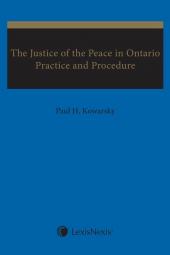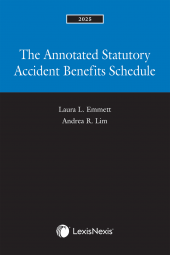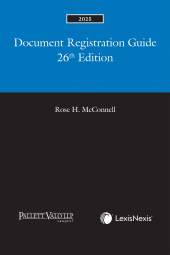The Justice of the Peace in Ontario: Practice and Procedure
One Year Subscription Only Terms
Subscribers receive the product(s) listed on the Order Form and any Updates made available during the annual subscription period. Shipping and handling fees are not included in the annual price.
Subscribers are advised of the number of Updates that were made to the particular publication the prior year. The number of Updates may vary due to developments in the law and other publishing issues, but subscribers may use this as a rough estimate of future shipments. Subscribers may call Customer Support at 800-833-9844 for additional information.
Subscribers may cancel this subscription by: calling Customer Support at 800-833-9844; emailing customer.support@lexisnexis.com; or returning the invoice marked 'CANCEL'.
If subscribers cancel within 30 days after the product is ordered or received and return the product at their expense, then they will receive a full credit of the price for the annual subscription.
If subscribers cancel between 31 and 60 days after the invoice date and return the product at their expense, then they will receive a 5/6th credit of the price for the annual subscription. No credit will be given for cancellations more than 60 days after the invoice date. To receive any credit, subscriber must return all product(s) shipped during the year at their expense within the applicable cancellation period listed above.
Product description
The Justice of the Peace in Ontario: Practice and Procedure outlines the role of Justices of the Peace and the daily execution of their extensive jurisdiction throughout Ontario in criminal, provincial and municipal proceedings.In writing this book, retired Justice of the Peace Paul Kowarsky aims to clear up the common misconception that the main responsibilities of Justices of the Peace are to solemnize marriages and deal with speeding tickets.
Rather, as he explains in the Preamble to the text, Justices of the Peace play a very important role in the legal system: "The Justice of the Peace in Ontario is the gateway to the administration of justice. It is irrefutable that the vast majority of people who are charged with crimes, provincial offences and municipal infractions will never meet a Judge. In the Bail Court, the Intake Court, the Trial Management Court or the Provincial Offences Intake and Trial Courts, the accused person will appear before a Justice of the Peace."
Given this broad range of significant responsibilities, it's critical that Justices of the Peace – both new and veteran – as well as the legal professionals who appear before them, understand their extensive jurisdiction and duties. This book is just the resource to provide that insight.
What's inside
The Justice of the Peace in Ontario: Practice and Procedure outlines the role of Justices of the Peace and the daily execution of their extensive jurisdiction throughout Ontario in criminal, provincial and municipal proceedings. Kowarsky covers all of the major relevant topics, including search warrants, bail and the Provincial Offences Act, and discusses the duties of Justices of the Peace in the various stages of proceedings and the different types of court.
The appendices at the end of the volume offer particularly helpful information as they outline the structure of the court system, list the criteria that are used in the Justice of the Peace selection process, and provide additional details about organizations related to the profession.
An invaluable reference
The Justice of the Peace in Ontario: Practice and Procedure is the only publication covering the duties of a Justice of the Peace, making it a must-have purchase for:
- Justices of the Peace who will benefit from having a handbook that outlines their duties
- Paralegals, since they appear primarily before Justices of the Peace, making a detailed knowledge of the jurisdiction of Justices of the Peace essential
- Paralegal schools/libraries who want to ensure their resources are comprehensive
- Articling students and junior lawyers who are seeking background information
- Justices of the Peace in the other provinces to enable them to understand and compare jurisdiction.
Table of contents
Chapter 1 - Jurisdiction
Chapter 2 - Criminal courts
Chapter 3 - Search warrants
Chapter 4 - Production orders
Chapter 5 - Peace bonds
Chapter 6 - Weapons prohibition orders
Chapter 7 - The Bail Court
Chapter 8 - The bail legislation
Chapter 9 - Bail in relation to Aboriginal accused persons
Chapter 10 - The Youth Bail Court
Chapter 11 - The Trial Management Court
Chapter 12 - Preliminary inquiries and summary conviction trials
Chapter 13 - Contempt of court
Chapter 14 - The Provincial Offences Act
Chapter 15 - The Provincial Offences Courts
Chapter 16 - P.O.A. search warrants
Chapter 17 - The Set Date/Trial Management Court
Chapter 18 - The path to P.O.A. trials
Chapter 19 - P.O.A. trial matters
Chapter 20 - Evidence
Chapter 21 - The defence case
Chapter 22 - Powers to control the process of the court
Chapter 23 - Contempt of court under the P.O.A.
Chapter 24 - Arrest and bail under the P.O.A. ,br>Chapter 25 - Proceedings against young persons under the P.O.A.
Chapter 26 - Additional general duties of Justices of the Peace
Appendix A
Principles of judicial office
Judicial independence
Structure of the Ontario Court of Justice
Decisions of the Court
Canada's court system
Appendix B
Qualifications and selection criteria
Education plan
Centre for Judicial Research and Education
Mentoring Program for the Toronto Region
The author's views on the Education Plan
Appendix C
The Association of the Justices of the Peace of Ontario
The Justices of the Peace Review Council
Justices of the Peace Remuneration Commission
 Lexis Nexis
Lexis Nexis 


